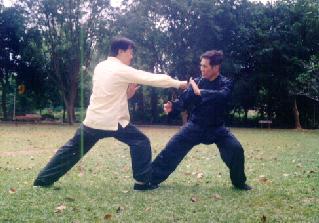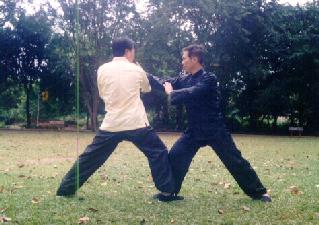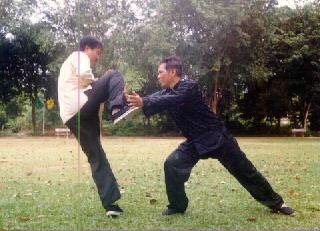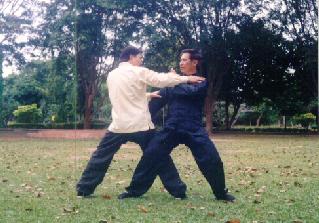GRASPING SPARROW'S TAIL AGAINST ALL ATTACKS!

|
Sifu, you mentioned that "Grapsing Sparrow's Tail" could be used against all forms of attack. Although I believe you, I find this hard to understand. Can you please enlighten us?
It is recorded in Taijiquan literature that when the great master Yang Lu Chan completed his training under Chen Chang Xin, he travelled all over China to have friendly sparring with many kungfu masters to test his fighting skills. Yang Lu Chan won all matches, earning the nickname "Yang, the Ever Victorous", And fundamentally he used only "Grasping Sparrow's Tail".
This application of only one fundamental Taijiquan pattern to overcome all forms of attack is of course difficult for many Taijiquan exponents today, particularly Taiji dancers, to understand. This webpage attempts to give an idea how this can be accomplished.
Attacks come in coutless ways, but all of them can be classified into four categories, namely
- striking with the hands, including elbows, shoulders and head
- kicking with the legs, including knees and shins
- felling an oponent by various means
- locking, holding and gripping an opponent's vial points

|

|
In the above illustration, Goh Kok Hin attacks me with with a thrust punch. As the strike approaches, I shift my body backward without moving my feet to avoid it, and as soon as the attack is spent and continuing the smooth curve of my backward shift, I move my body and arms forward in the "peng" technique of "Grasping Sparrow's Tail", warding off the attacking arm and with my fingers pointing at the opponent's throat, warning him that I could jab into his throat had I wanted to.
If one can effectively counter a middle-level strike like above, he can also counter any middle-level strikes irrespective of what hand-forms or stances the opponent may use. For example, if Goh Kok Hin attacks me with a pheonix-eye fist instead of a level fist, and uses a false-leg stance instead of a bow-arrow stance, I could still use the same "peng" technique against him.

|

|
In the second series, Goh Kok Hin attacks me with a side kick. Following his kicking momentum, I shift my body backward without moving my feet, and hold his leg using the "lu" technique of "Grasping Sparrow's Tail". Immediately, I step my left back foot forward, but still behind my right front foot, and shoot out my front foot into the right bow-arrow stance, simultaneously throwing Goh off the ground. If I wish, I may twist his angle before throwing him off.
With some modification, this same technique can be used against a high kick or a low kick. If the kick is high, just shift the body backward to avoid the kick without catching the attacking leg. As the opponent lowers his attacking leg, but before it touches the ground, shoot forward and throw him off with a following "li" or "an" technique, taking precaution that he may use his same leg or the other leg to kick, or any other parts of his body for an attack as you move in.
You may also use the same technique against a round-house kick or a knee-jab, but appropriate modifications are necessary to suit the suituation. You should, for example, avoid the full force of the attack, go along with the opponent's attacking momentum, then counter attack him when his initial attack is spent.

|
In the next category of attack, Goh Kok Hin attempts to fell me using a pattern kinown in Shaolin Kungfu as "Uprooting a Tree". He places his right font leg behind my right front leg, guards against my hands, and pushes me to fall backward. I move my left back leg backward in a arc to my right side, and following the momentum of his push I grip his two elbows and pull him to fall diagonally forward. This is also the "lu" technique of "Grasping Sparrow's Tail".
With appropriate modifications, this technique can be used against other types of felling attacks. For example, if an opponent holds my arm and attempts to throw me over his shoulder, I adjust my stance suitably to frustrate his leverage advantage and turn it against him, grip his elbow nearer to me and pull, and simultaneously sweep his neck with my other arm to fell him backward onto the ground.

|

|
In the fourth category of attacks, Goh Kok Hin grips my two upper arms near the elbows. I adjust my position so that my bow-arrow stance is perpendicular to his two legs, and simultaneously fold my right arm above his two arms, and press down my right forearm hard against his two wrists, causing him to release his grip. If he stubbornly holds on to my arms, his wrist would be dislocated. Immediately I shoot forward using the "li" technique of "Grasping Sparow's Tail", felling the opponent backward.

|
I must make sure that in his falling, he cannot attack me with his hands or any parts of his body, or if he does I can effectively frustrate his attack. Special precaution must be taken against the possibility of his kicking as he falls.
If I wish to be distructive, instead of felling him backward I could inflict internal injury on him by striking his chest with my forearm using internal force. But this is to be discouraged. Taoist philosophy, on which Taijiquan is based, teaches that "it is the virtue of heaven to love life" (shang tian you hao sheng zi te in Chinese). We should therefore "live and let live".
If an opponent grips my forearm, I can also use the technique in a similar way. In such a situation, I would use the turning of my two wrists, instead of the pressing down of my right forearm as above, to release his grips on my forearms. If the opponent grips my arms from behind, I could still apply the same technique, but I would have to employ flowing movement to adjust my position so that I would face him frontally or sideways.

|

|
It is important to realize that techniques constitute only one of the numerous factors for effective combat; other factors include force, timing, spacing, judgement and fluidity of movement. In felling an oponent, for example, if you apply the technique too late, the opponent would fell you instead. If you apply the technique too early, you would be unable to exploit the opponent's force, resulting in your turning Taijiquan into Japanese sumo or western wrestling, which is not uncommon with students trying to apply combat techniques without systemmatic training.
